1970









© Estate of Terry Fox. Photos: Barry Klinger
Liquid Smoke
1970
action
without audience
elements: liquid smoke, cement wall
place: Third Street, San Francisco, Kalifornien / California, USA
»Throwing liquid smoke against the wall was really an anarchistic gesture, like thowing a Molotov cocktail. But it wasn’t really that at all. As soon as the glass vital exploded on the cement, it became an aesthetic event. Exposed to the air, the liquid began to smoke until it had completely evaporated. It was so extraordinary and so unrelated to any previous ideas you had about that material that it became art. You would never think of a cement wall smoking, and to see it happening was stunning.«, [Ausschnitt / excerpt], zit. nach Kat. / cat. Berlin / Essen 1982, S. / p. 15
excerpt: Terry Fox - Metaphorical Instruments, Museum Folkwang, Essen 1982, daadgalerie, Berlin, 1983, p. 15
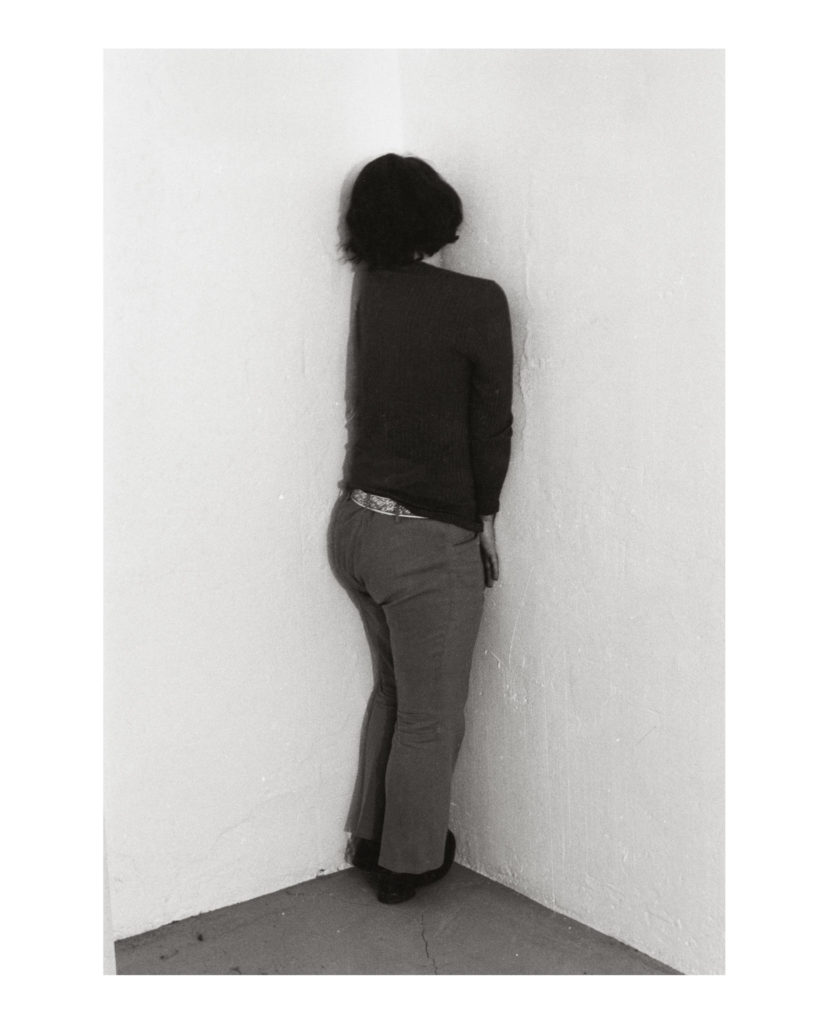
Corner Push
1970
action
without audience
place: Reese Palley Gallery, San Francisco

Levitation
1970
I. action
without audience
place: Reese Palley Gallery, San Francisco, California, USA
duration: six hours
II. installation, temporary
with audience
September 17 – 20, 1970
place: Richmond Art Center, Richmond, Kalifornien / California, USA
curator: Tom Marioni
»The first thing I did was to cover the sixty by thirty foot floor with white paper and to tape white paper on the walls. The floor had been dark, but it became such a brilliant white that if you were at one end of it, it glared, it hurt your eyes to look at someone standing at the other end. It was such a buoyant space that anyone in it was already walking on air. Then I laid down a ton and a half of dirt, taken form under a freeway on Army Street, in an eleven and a half foot square. The mold was made with four redwood planks each twice my body height – I used my body as a unit of measure for most of the elements in the piece. […] I fasted to empty my body. […] I drew a circle in the middle of the dirt with my own blood. Its diameter was my height. According to the medieval notion, that creates a magic space. Then I lay on my back in the middle of the circle, holding four clear polyethylene tubes filled with blood, urine, milk and water. They represented the elemental fluids that I was expelling from my body. I lay there for six hours with the tubes in my hand trying to levitate. The doors were locked. Nobody saw me. I didn’t move a muscle. I didn’t close my eyes. I tried not to change my focal point. […] I was trying to think about leaving the ground, until I realized I should be thinking about entering the air. For me that changed everything, made it work. I mean, I levitated. After the fourth hour I couldn’t feel any part of my body, not even my chest expanding and contracting. My legs and arms were probably asleep. I felt I was somewhere else. I’d gone, I’d left my body. Then something weird happened. A fly started buzzing around, and I thought I was the fly. That hallucination didn’t last very long, but the feeling of being out of my body persisted about two hours.«
excerpt: Avalanche, No 2, Winter 1971
»Less than one week after the show opened I was forced to close it by the city’s administration because it was considered obnoxious.«
excerpt: Tom Marioni, Terry Fox: himself. In: Art and Artists, London, Jan 1973
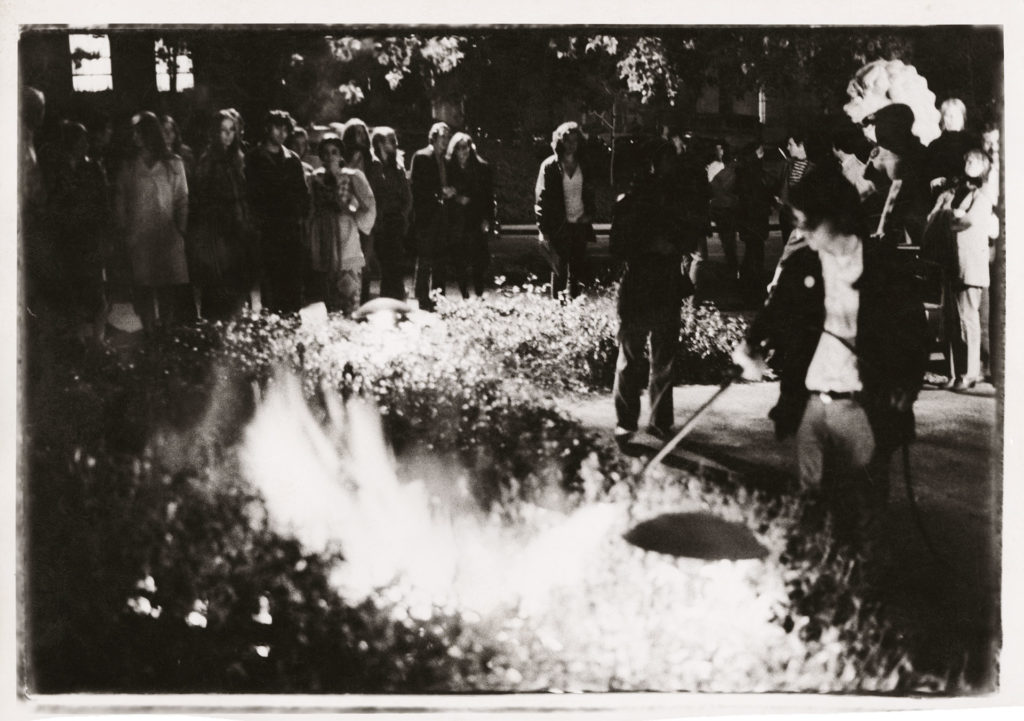
Defoliation
1970
action
with audience
place: Power Plant Gallery, University Art Museum, University of California, Berkeley,
opening night of the exhibition The Eighties / March 17, 1970
elements: Chinese jasmine (star jasmine), flame thrower
»This was my first political work. I wanted to destroy the flowers in a very calculating way. By burning a perfect rectangle right in the middle, it would look as though someone had destroyed them on purpose. The flowers were Chinese jasmin planted five years ago which were to bloom in two years. It was also a theatrical piece. Everyone likes to watch fires. It was making a beautiful roaring sound. But at a certain point people realized what was going on – the landscape was being violated; flowers were being burnt. Suddenly everyone was quiet. One woman cried for twenty minutes.«,
excerpt: Terry Fox - Metaphorical Instruments, Museum Folkwang, Essen, 1982, daadgalerie, Berlin, 1983, p. 12

Turgescent Sex
1971
action / video
without audience
video: black-and-white, sound, 40 min
camera: George Bolling / produced by Terry Fox.
place: Artist’s Studio, 16 Rose Street, San Francisco
First shown in 1971 at the exhibition Prospect 71: Projections in Düsseldorf.
»This is a performance for the video camera and was made to be sent out, like a letter. In this tape, I wash my hands / wash the fish bound by the rope in many knots / blindfold myself with the bandage / release the fish from bandage / cover the nest with smoke. The sound is the flow of traffic outside my door, the light is the sunlight on my floor. Unedited, taped in my studio in San Francisco by George Bolling on a Sony Portapak in 1971.«
excerpt: Terry Fox, 1976, in: Anna Canepa Video Distribution, catalogue, New York, 1976, p. 6, 7
»This piece is a personal statement on the escalation of the Vietnam War. Blindfolded, Terry Fox tries to free a dead fish from a rope with countless knots. There is always the danger of confusing the ends of the cord and thus creating new knots. This procedure can be compared to the system and complexity of the war.«,
excerpt: (RE/DE) CONSTRUCTIONS & c., exhibition catalogue, Fridericianum Kassel, 2003, p. 54
Yield
1973







© Estate of Terry Fox. Photos: Larry Fox
Installation, temporary & action
duration: three days
with audience (could not enter the performance space)
place: University Art Museum, Berkeley, Kalifornien / California, USA
elements:
– 22 photographs / model of Chartres labyrinth
– a blackboard with a drawing
– objects, seen in the photographs, placed on a blackboard
– four 50 foot tubes of blood, urine, milk and water
– 12 foot high / 40 foot long curtain out of translucent muslin
first day: flour, water, metal bowl
second day: flour, water, metal bowl, square mirror on the floor (8 foot), mirrored bowl, smoke
third day: a metal bowl, dried flour, smoke, a mirrored bowl, an enamel bowl, a loaf of bread, a spoon, a heating bowl
»Terry Fox is one avantgarde performer who never loses sight of the fact that an artist makes a legitimate claim to our attention only through his art, rather than the other way around, and a riveting demonstration of his magical work is now on display at the University Art Museum in Berkeley.
On the surface, Fox’s work falls within the fashionably far-out genre of ›process‹, ›body‹ or ›performance‹ art. All too often, the outpourings from this school turn into narcissistic exercises in autistic theater by artists about whose personalities or psyches most of us couldn’t care less.
Fox, however, has forged a uniquely compelling form of his own which brings together art and personal experience in the most forceful manner since abstract expressionism. […] Watching Fox perform his slow, hypnotic ritual, one gets the sense of peering through a membrane that forms a flimsy barrier between the mundane and the magical, to glimpse a secret chamber where life is being made and moves according to an eternal time scale.
Of course, the piece may look altogether different by now. Like life itself, it is a work in process, and one can view it only in glimpses. But one brings away from it an altered sense of time an rhythm that runs as a new undercurrent to day«,
excerpt: Thomas Albright, From Life to Art. A Magical Demonstration, in: San Francisco Chronicle, 13. September 1973


Children’s Tapes
1974
series: Works from the Labyrinth, 1972-1978
video: black-and-white, sound, 30 min.
camera: Terry Fox, San Francisco
location: Terry Fox’ Atelier, San Francisco, March 1974, between midnight and sunrise
150 min., »distributed in a 30 minutes collection of 11 of the shorter tapes«
The 34 tapes were made for children. The same simple elements (fork, spoon, bowl, candle, water, match) are used in sculptural, ›scientific‹ and playfull ways. All tapes shot on the same table and under the same light in extreme close up.
Terry Fox produced the tapes in 1974 for the traveling exhibition Circuit, curated by David Ross, shown in Los Angeles and at the Kölnischer Kunstverein (curator: Wulf Herzogenrath)
»Children’s Tapes is a classic early video work, a seminal investigation that translates the aesthetics of minimalism, performance, perception and real time into the vernacular of the everyday. With ingenuity and wit, Fox constructs phenomenological dramas from the science of the quotidian. Suspense and surprise suffuse a series of anecdotal episodes that demonstrate basic physical phenomena. Fox builds dramatic tension and mystery with an extreme economy of means, focusing a stationary black-and-white camera on ordinary household objects. With the camera close to his still-life subjects, Fox constructs a series of elementary experiments that illustrate fundamental principles of physical science: A piece of fruit is placed under a tin lid held up by a single match, as an unsuspecting fly approaches the bait; a spoon, balanced on a fork, holds a piece of ice until the melting water topples it; a candle in a pan of water is extinguished when a pot is placed over it. The intimate scale, magnified view, and suspenseful unfolding of minute events in real time all serve to intensify the viewers’ perceptions and expectations in these engaging mini-narratives.«
Electronic Arts Intermix, New York, 2016
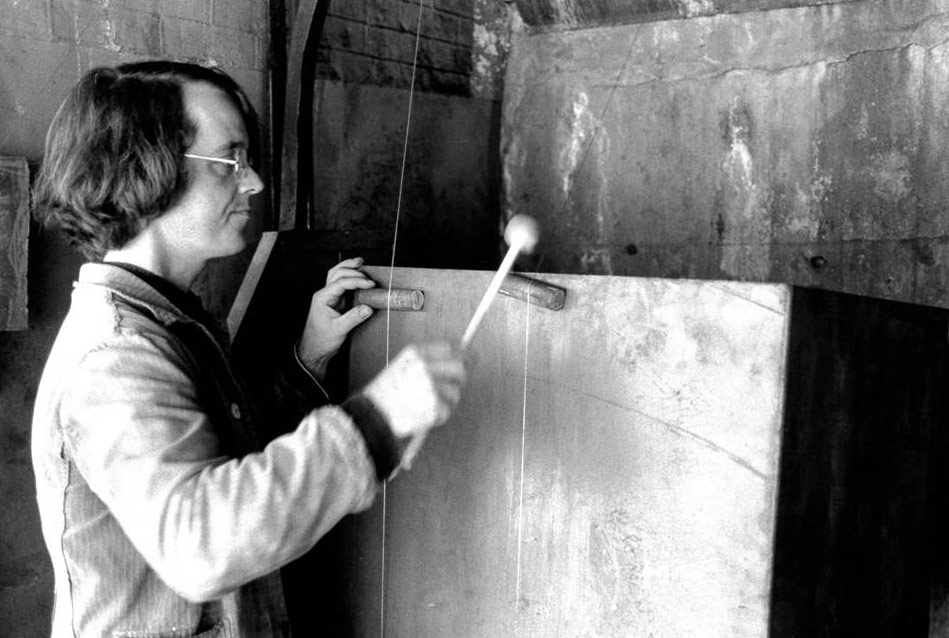

The World’s Largest Guitar
1978
action, with sound
public space
with audience / random passersby
place: under the pedestrian sidewalk of Mission Street, San Francisco, between Third and Fourth Streets
elements: one large metal box container (open on the top), piano wire, metal
elevator doors in the side walk, violin bows, sticks,
solo exhibition: San Francisco Art Insitute, San Francisco, Kalifornien / California, USA
»I had been offered an exhibition at the San Francisco Art Institute. I gave the space to another artist, Thomas Cochran. During the month-long exhibition period, I worked under the Mission Street sidewalk near Third Street.«
excerpt: Terry Fox – Ocular Language, Gesellschaft für Aktuelle Kunst, Bremen, 2000, p. 143
»My studio was only a block away from Terry’s studio, so we would both visit each other often. One early afternoon (like lunch hour), Terry took me to where there was an empty building lot that was next to his studio. In the empty lot, you could go underneath the sidewalks; it was kind of like a cavern that you could enter under the street. From under the street, when you were looking up, you could see two metal elevator doors. It would move a few inches up and down when anybody walked past it and there was a lot of pedestrian traffic. So Terry wanted to show me his new project so he attached a piano wire on to part of one of the elevator doors and he found a discarded 80 pound metal desk and he attached the other end of the piano wire to the leg of the desk. So the wire suspended the weight of the 80 pound desk which made it very taut. Terry would strike the piano wire with a chop stick continuously which caused a drone. The drone would vibrate out of the cavernous area and travel about 50 feet to a side of a building which would bounce out and circulate back to where we were so the sound made this very circular motion. This was all orchestrated by the accidental movement of the pedestrian stepping on and off the elevator door that changed the tension of the wire.«
Memory text by Al Wong, San Francisco, May 11, 2019 / written for the project Living Archive (ark-hive) – Terry Fox

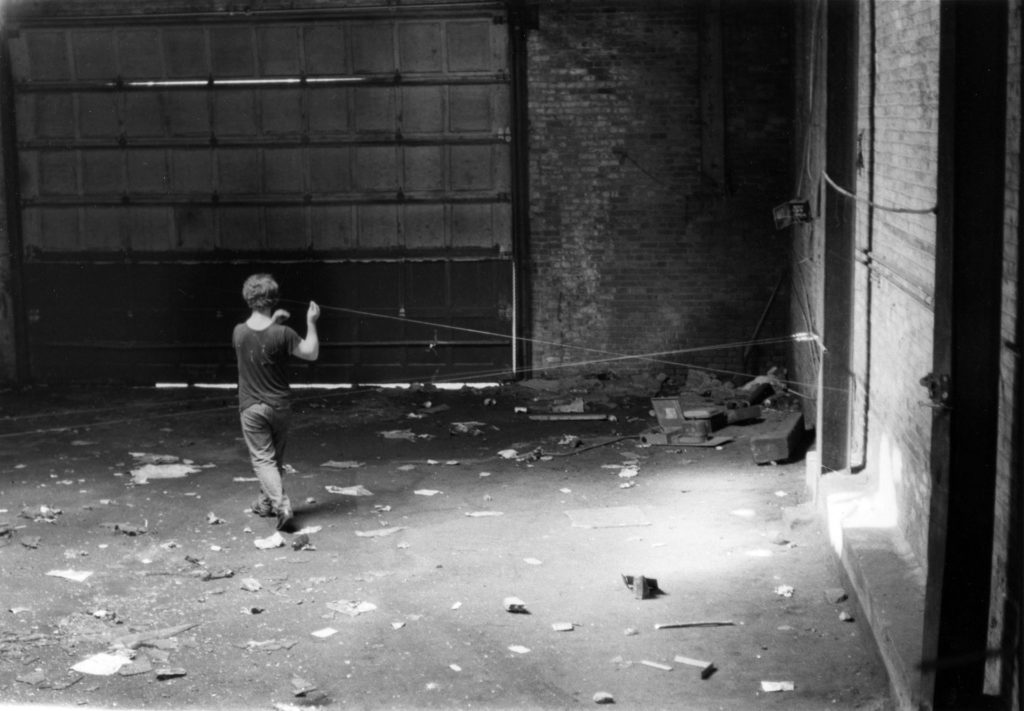
Erossore
1979
action, with sound
with audience
place: New York City, New York, USA (King Street and West Houston Street, in an abandoned building on a vacant lot
elements: three rosined piano wires (first stroked lengthwise with fingers), turnbuckles
»While living in Soho, I passed a vacant lot on the corner at King and West Houston Streets every day and noticed that the lot had an abandoned building on it with very large metal doors. I was curious what kind of sound these metal doors would make with piano wires. I stretched three wires in a triangular shape of that filled the empty space. During this event, for the first time, the wires were attached at shoulder height instead of being attached to the floor. The metal became a powerful resonator for the wires. It produced a totally different sound than attaching them to wood as I had done before. Erossore was also the first public performance in which I stroked the rosined piano wires horizontally with my fingers while walking along them.«
excerpt: Terry Fox – works with sound, Stadtgalerie Saarbrücken, 1999, p. 72





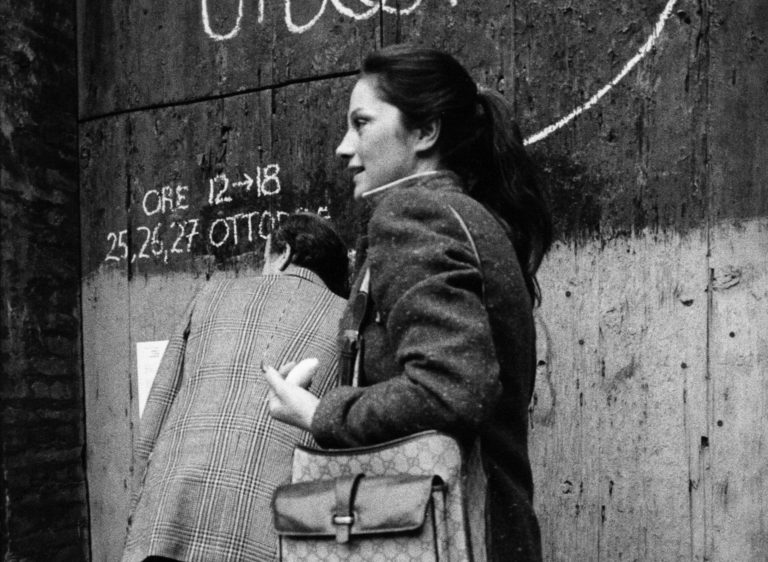
© Estate of Terry Fox. Photos: Enzo Pezzi
Suono Interno
1979
action, with sound
with audience, random passersby
duration: three days, six hours each day
place: Chiesa Santa Lucia, Bologna, Italy
elements: two piano wires (stroked and beaten)
»In 1979 I obtained permission to use the ex-church of Santa Lucia in Bologna for a three-day performance. The church was totaly empty and abandoned for years. Since one of the conditions for this permission was that no one other than myself was to be allowed inside the structure, I resolved to use an eye-sized hole in a door as the central point of my performance. I found a wooden covering over a hole in the floor that led to the crypt. This covering was very resonant and directly in line with the hole in the door, which was also extremely resonant.
I swept a path in the bird droppings between the door and the crypt cover and then stretched two parallel piano wires between them, approximately 100 meters long. When one peered into the hole in the door from outside the church, two lines could be seen diminishing to a point, like a diagramm in simple perspective. The heavily rosined wires were played by stroking and pulling them gently with the fingers. The sound produced was very voluminous and could be heard from the street. The words „Suono Interno“ (internal sound) were chalked on the door with an arrow pointing to the eye-hole so that passersby, attracted by the sound, could peer in and discover its source.«
excerpt: Terry Fox – works with sound, Stadtgalerie Saarbrücken, 1999, p. 75